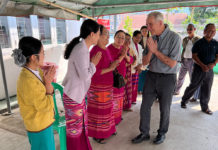Trash and the average Joe
EDITOR: We would like to thank the staff of the Sonoma West Times and News for helping us educate our fellow citizens about the problem of trash in our environment and our efforts to remove it. Since your wonderful article on Jan. 7 we have had people asking us three basic questions; why is this news, how does this affect me and how can I help?
As volunteer coordinators for marine debris for the Stewards of the Coast and Redwoods, we are uniquely qualified to answer these questions. The articles printed are newsworthy in the fact that for well over a decade, we do a monthly cleanup on Salmon Creek Beach. As part of our monitoring, we do a first flush survey after the mouth of the river is opened, traditionally we pick up between 750 to1000 lbs. of trash. We pick up dozens of shoes, socks, Levis, shirts, bras, sleeping bags, lawn chairs and toiletries, all shredded by our river.
It’s like a house has collapsed into the river but we know it hasn’t. This year is different. We now have Chris Brokate and the “Garbage Patch Kids.” These absolute heroes have removed hundreds of thousands of pounds of trash out of our river bottom this last year and our first flush survey quantifies what they have done. Instead of 1,000 lbs., we got just over 100 lbs. all small stuff. That is a 90 percent drop in the amount of debris.
So how does this affect the average Joe? Along our coast there are approximately 100,000 visible pieces of plastic per square mile and an upwards of 600,000 pieces of micro plastic. It’s the most invasive pollutant in our oceans, virtually every animal tests positive for plastics in some form and all of the affects are negative. We are going to stick to one affect that has been in the news lately. Have you had any local Dungeness crab lately? Consider this, algae in the ocean depends on the temperature, which means, warmer water makes more algae. The algae traditionally forms on shells, rocks and wood in the water. Diatoms live on the algae when they come into contact with uric nitrogen they release Domoic acid. This acid causes brain damage in birds and mammals. The acid collects in invertebrates and passes up the food chain. Normally the ocean cools by Oct. and we have crab for Thanksgiving; but now we have the “blob” on top of an El Nino coupled with 100,000 visible pieces of plastic, all of it growing algae with diatoms releasing acid and we have no crab. So our fleet is idle and their crews are hurting. Local stores have had a drop in revenue and our tourist count is down which means less people coming here to feast on crab.
We have a large chunk of two industries collapsing because of pollution and litter. How can the average Joe help? With 80 percent of the plastic in the ocean being land based, we ask everybody to pick it up when you see litter lying on the ground. Don’t walk by it; pick it up.
We also urge people to join organized cleanups. For ocean cleanups people can go to thestewardsofthecoastandredwoods.org or call 869-9177.
We also do a once a month cleanup on Salmon Creek. There will be an Earth Day cleanup in Jenner and special group cleanups for river and land that people can go to. Check out cleanriveralliance.com to find out more. We meet in the Guerneville Plaza every Monday with ongoing cleanups on variable days. People can also donate for ocean cleanups call the steward’s office in Armstrong woods at 869- 9177 ext. 2.
For river and land cleanups people can mail checks made out to Russian Riverkeeper with Clean River Alliance on the memo line and mail it to Russian Riverkeeper P.O. BOX 1335 Healdsburg, CA 95448
Keary and Sally Sorenson
Sebastopol
All beings
EDITOR: The “Sonoma County Winegrowers’ 2nd Annual Sustainability Report” is just another spin project. While their “Defining Sustainability” is laudable, vineyards by definition are not sustainable. Grape growing is monocropping, which is bad for the soil, bad for the natural ecology and in reality does not reap nearly the dollars per acre as, for example, Singing Frogs Farm does. This small farm, where their practices actually are sustainable, grows life giving food, and sensitive humans can not only taste the resulting quality but can feel the differences in his or her body.
I drive by acres and acres of nothing but grape vines and feel no life giving energy at all. The massive spraying of Roundup or other deadly chemicals to “control weeds” is lethal to not only humans but to any being who inhabits the soil. Soil is a living, breathing organism that survives and thrives when we focus on restoring the degradation that monocropping agriculture has caused over the years here in Sonoma County.
Humans buying up ranch land and turning them into designer wines may bring in tax dollars, but at what costs to all being living in Sonoma County? My husband, a friend and I, along with our four-legged family member, recently drove to the Lodi area to partake in a free tour offered by the California Department of Fish and Wildlife to hear about and see the Sandhill Cranes that overwinter in this area. You can see the detriment of vineyards on the prehistoric and awesome birds. They have no access to the land on which grape vines are planted since their wingspan is much too great to negotiate these fields that have been planted between levies. The Nature Conservancy, the California Department of Fish and Wildlife plus numerous “duck clubs” are working to revert more of the land back to wetlands where Sandhill Cranes have come to overwinter for millennia.
When are we humans going to expand our thinking to include other being besides ourselves?
Respectful of all beings,
Cathie Haynes
Sebastopol
59.6
F
Healdsburg
April 18, 2025







